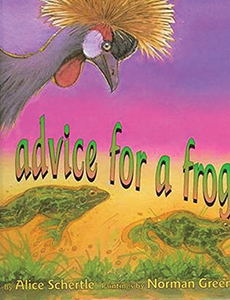The Book That Changed My Life: Advice for an Author
I came across Alice Schertle’s book Advice for a Frog, published in 1995 and illustrated by Norman Green, at a time when I was still trying to find my voice in children’s literature.
 I came across Alice Schertle’s book Advice for a Frog, published in 1995 and illustrated by Norman Green, at a time when I was still trying to find my voice in children’s literature. I’d written two middle-grade novels (rejected); countless picture-book texts (all rejected); many, many adult poems (let’s not even go there); and a handful of children’s stories and poems mercifully accepted by Cricket magazine. Like most hardworking but underpublished writers, I felt I was waiting for something — a sign, a path, a sympathetic editor — to steer me toward my truest writing self.
I came across Alice Schertle’s book Advice for a Frog, published in 1995 and illustrated by Norman Green, at a time when I was still trying to find my voice in children’s literature. I’d written two middle-grade novels (rejected); countless picture-book texts (all rejected); many, many adult poems (let’s not even go there); and a handful of children’s stories and poems mercifully accepted by Cricket magazine. Like most hardworking but underpublished writers, I felt I was waiting for something — a sign, a path, a sympathetic editor — to steer me toward my truest writing self. Animal poems were my latest experiment. Some of them clicked, some of them seemed silly and facile. The problem was translating the fascinating complexity of the natural world into what I thought children’s poetry should be. Enter Advice for a Frog (which I first borrowed from the library, but then promptly bought, hoping its brilliance would somehow seep into me by osmosis). This book, a loose collection of poems about important/extraordinary/endangered animals, blew me away with its wry humor and dazzling language. Fruit bats “flit among / the swollen globes, lancing / the tender skins and sucking sweet / juices.” A vulture “hunches on the plain. / His bald head bowed with grief, / he stays until the / smooth white bones / are clean.” An iguana dreams of its dragon forebears, and a rat thanks “the God who made both rats and men.”
Animal poems were my latest experiment. Some of them clicked, some of them seemed silly and facile. The problem was translating the fascinating complexity of the natural world into what I thought children’s poetry should be. Enter Advice for a Frog (which I first borrowed from the library, but then promptly bought, hoping its brilliance would somehow seep into me by osmosis). This book, a loose collection of poems about important/extraordinary/endangered animals, blew me away with its wry humor and dazzling language. Fruit bats “flit among / the swollen globes, lancing / the tender skins and sucking sweet / juices.” A vulture “hunches on the plain. / His bald head bowed with grief, / he stays until the / smooth white bones / are clean.” An iguana dreams of its dragon forebears, and a rat thanks “the God who made both rats and men.”These were real poems — grisly, complicated, and beautiful. Full of aha moments. They celebrated subjects children cared about, but they did not talk down to young readers. The trim size was big and the illustrations lush. Each poem had a chance to glimmer and expand in the reader’s mind. And even more exciting, the author had added further information about each creature at the back of the book, for people who wanted to know more (I always wanted to know more).
Schertle’s book had an electrifying effect on me. Maybe, I thought, I could flex my poetic muscles a bit. Maybe I could combine poetry and science in an interesting way. Maybe I could finally write that book I’d been pondering — about creatures in a pond — not as a straight picture book, but as a book of poetry with different pond-creature voices. Instead of abandoning all the extra fascinating details that didn’t fit into the poems, I could include them in a nonfiction note. My brain began to buzz with possibilities.
Soon after, I started work on Song of the Water Boatman and Other Pond Poems, which became my first book with editor Ann Rider at Houghton Mifflin. Water Boatman and illustrator Beckie Prange went on to win a 2006 Caldecott Honor, and Ann Rider has been my editor ever since. I found my voice, my publisher, and my career.
P.S. I now own many of Alice Schertle’s books. My current favorite is Button Up!: Wrinkled Rhymes. She is still brilliant and she still never talks down to children. Thank you, Alice!
From the May/June 2018 Horn Book Magazine: Special Issue: Making a Difference. For more in this series click the tag Book That Changed My Life.
RELATED
RECOMMENDED
ALREADY A SUBSCRIBER? LOG IN
We are currently offering this content for free. Sign up now to activate your personal profile, where you can save articles for future viewing.







Add Comment :-
Be the first reader to comment.
Comment Policy: